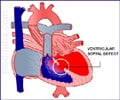Successful stent implantation and follow-up coarctectomy in premature infants suffering from aortic coarctation has been achieved by cardiac interventionalists
Successful stent implantation and follow-up coarctectomy in premature infants suffering from aortic coarctation has been achieved by cardiac interventionalists and surgeons at University Clinic in Leuven, Belgium.
Full findings are published in the March issue of Catheterization and Cardiovascular Interventions, the official journal of The Society for Cardiovascular Angiography and Interventions.Aortic coarctation is a common congenital condition characterized by a narrowing of the aorta, a major blood vessel leaving the heart. The narrowed aorta reduces blood flow to the lower extremities and causes heart failure in infants. The condition may be diagnosed at birth or in early childhood, at which time it can be corrected by surgery, however surgical repair is extremely risky in premature babies. Prostaglandin E1 infusion is the standard treatment to recover or maintain systemic flow in a neonate (infant) with critical coarctation prior to elective surgical repair. However, this treatment may not restore sufficient blood flow in time and can be associated with considerable side effects when given for a prolonged time.
A research team led by Marc Gewillig, M.D., Ph.D., evaluated the safety and efficacy of stenting a coarcted aortic arch in critically ill neonates in order to defer corrective surgery until the infants had stabilized and gained weight. Dr. Gewillig explained, "Significant arch obstruction in critically ill infants currently requires a surgical intervention, but how and when to proceed with the surgery is crucial to successful outcomes. Our goal of stenting the coarctation was to provide the surgeon with a bigger and better patient for surgery to correct the arch obstruction."
The study covered 15 infants less than 2 months of age between January 1, 1998 and March 30, 2009. The infants were between 30-41 weeks of gestation; 8 out of 15 were premature (<37 weeks of gestation). At cardiac catheterization, the average weight of the patients was 2.5 kg and their mean age was 12 days. One group of patients had a native coarctation where surgery was not considered the best option at that time (very low-birth-weight, critically ill neonates not responding to medical treatment, complex cardiac, and noncardiac disease); a second group consisted of patients with significant early restenosis after primary surgical coarctectomy or arch repair.
Stent removal and arch reconstruction has been performed in 12 patients. One patient is still awaiting final repair. In patients with simple stented coarctation, the stent was removed after 2.8 months. In complex cardiac malformation, stents were removed after 3.0 months. The decision when to remove the stent was made for every patient individually: criteria were hemodynamic stability after the cardiogenic shock, adequate body weight to safely perform coarctectomy, or when additional surgery was planned. Most patients with simple coarctation could easily be weaned from supportive therapy as systemic output had adequately resumed. Two deaths occurred before stent removal and were nonprocedure related.
Commenting on the surgery, Dr. Gewillig said, "The surgeon felt the procedure was not complicated by the presence of the stent and the surgery was easier to perform as all structures had grown, with some catch-up growth of the distal arch."
Advertisement
Advertisement
RAS











